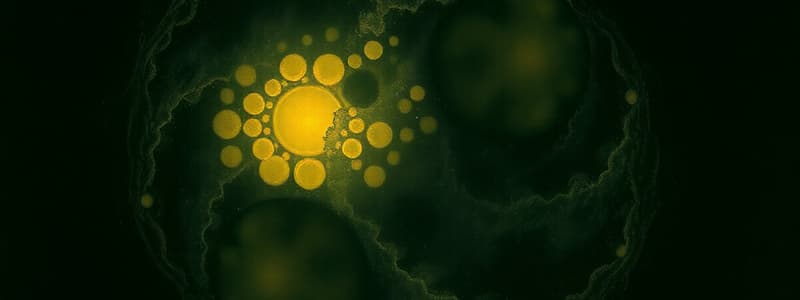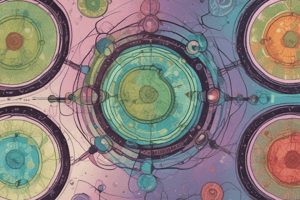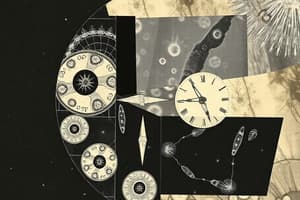Podcast
Questions and Answers
What is meiosis?
What is meiosis?
Formation of reproductive cells (egg and sperm)
What is asexual reproduction?
What is asexual reproduction?
Production of offspring from one parent
What type of cell division does asexual reproduction use?
What type of cell division does asexual reproduction use?
Mitosis
What does asexual reproduction produce?
What does asexual reproduction produce?
Is there genetic diversity in asexual reproduction?
Is there genetic diversity in asexual reproduction?
What are the five types of asexual reproduction?
What are the five types of asexual reproduction?
What is the new individual cell made during sexual reproduction called?
What is the new individual cell made during sexual reproduction called?
Is meiosis considered asexual reproduction?
Is meiosis considered asexual reproduction?
What is meiosis the formation of?
What is meiosis the formation of?
What happens during mitosis?
What happens during mitosis?
What does meiosis result in?
What does meiosis result in?
What is missing from the table?
What is missing from the table?
What is the Cell cycle aka?
What is the Cell cycle aka?
Is the cell cycle a series of individual steps?
Is the cell cycle a series of individual steps?
What are the three main divisions of the cell cycle?
What are the three main divisions of the cell cycle?
What is the longest division of the cell cycle?
What is the longest division of the cell cycle?
What is interphase divided into?
What is interphase divided into?
What phase of the cell cycle does the cell never leave?
What phase of the cell cycle does the cell never leave?
What is mitosis divided into?
What is mitosis divided into?
What is cytokinesis?
What is cytokinesis?
What all happens during the G1 phase?
What all happens during the G1 phase?
What is the longest period of Interphase?
What is the longest period of Interphase?
What phase of interphase is when chromatin duplicated?
What phase of interphase is when chromatin duplicated?
What is each piece of duplicated chromatin held together by?
What is each piece of duplicated chromatin held together by?
This follows anaphase
This follows anaphase
Made up of the G1, S and G2 phases
Made up of the G1, S and G2 phases
Cleavage furrow forms during this portion of the cell cycle
Cleavage furrow forms during this portion of the cell cycle
Formation of the cell plate in plants occurs during this portion of the cell cycle
Formation of the cell plate in plants occurs during this portion of the cell cycle
What is this
What is this
Spindle fibers disappear during this phase
Spindle fibers disappear during this phase
Nitrogen base that always binds to guanine
Nitrogen base that always binds to guanine
Phase of the cell cycle which occurs after cytokinesis
Phase of the cell cycle which occurs after cytokinesis
Phase during which centriols move to opposite sides of the cell
Phase during which centriols move to opposite sides of the cell
2N
2N
Phase of the cell cycle which occurs after mitosis
Phase of the cell cycle which occurs after mitosis
This pair of sex chromosomes is found in a female
This pair of sex chromosomes is found in a female
Portion of interphase during which DNA is copied
Portion of interphase during which DNA is copied
Portion of interphase during which cells grow in size
Portion of interphase during which cells grow in size
Longest period of interphase
Longest period of interphase
Type of reproduction that results in genetically identical cells
Type of reproduction that results in genetically identical cells
Portion of interphase during which to cell prepares for division
Portion of interphase during which to cell prepares for division
Phase where chromatin begins to coil into chromosomes attached at the centromere
Phase where chromatin begins to coil into chromosomes attached at the centromere
Chromosomes are found in this part of the cell
Chromosomes are found in this part of the cell
Spindle fibers shorten and sister chromosomes are drawn to opposite poles in this phase
Spindle fibers shorten and sister chromosomes are drawn to opposite poles in this phase
Division of the nucleus
Division of the nucleus
Two of these are attached by a centromere
Two of these are attached by a centromere
Division of the cytoplasm
Division of the cytoplasm
Term used to describe the center of the cell when chromosomes are lined up
Term used to describe the center of the cell when chromosomes are lined up
Phase where the spindle apparatus forms in animal cells
Phase where the spindle apparatus forms in animal cells
Phase where chromosomes move to the center of the cell
Phase where chromosomes move to the center of the cell
Time interval between cell divisions
Time interval between cell divisions
Phase of the cell cycle which follows interphase
Phase of the cell cycle which follows interphase
Term used to describe the non-dividing phase of muscle and nerve cells
Term used to describe the non-dividing phase of muscle and nerve cells
Used by cells to guide the separation of sister chromatids into two daughter cells
Used by cells to guide the separation of sister chromatids into two daughter cells
Nitrogenous base that always bind to thymine
Nitrogenous base that always bind to thymine
Cell division resulting in daughter cell being much smaller than parent
Cell division resulting in daughter cell being much smaller than parent
Phase used for karyotyping cells
Phase used for karyotyping cells
Ratio which helps determine when a cell should divide
Ratio which helps determine when a cell should divide
Term used to describe cell division in prokaryotes
Term used to describe cell division in prokaryotes
Phase during which centromeres divide
Phase during which centromeres divide
Nuclear envelopes reassemble during this phase
Nuclear envelopes reassemble during this phase
Non-sex chromosomes
Non-sex chromosomes
Photograph showing all the chromosomes in a person's body
Photograph showing all the chromosomes in a person's body
Diploid number in human
Diploid number in human
Is chromatin or chromosomes present in G1 interphase?
Is chromatin or chromosomes present in G1 interphase?
Is chromatin or chromosomes present in S phase?
Is chromatin or chromosomes present in S phase?
Is chromatin or chromosomes present in cytokinesis?
Is chromatin or chromosomes present in cytokinesis?
Is the DNA joined or individual in G1 Interphase?
Is the DNA joined or individual in G1 Interphase?
Is the DNA joined or individual in Prophase?
Is the DNA joined or individual in Prophase?
Is the DNA joined or individual in Cytokinesis?
Is the DNA joined or individual in Cytokinesis?
How many nuclei are present in G1 interphase?
How many nuclei are present in G1 interphase?
How many nuclei are present in Prophase?
How many nuclei are present in Prophase?
Flashcards
Meiosis
Meiosis
The process of converting a diploid cell to a haploid gamete, causing genetic variation in offspring.
Asexual Reproduction
Asexual Reproduction
The production of offspring from a single parent, resulting in genetically identical offspring.
Mitosis
Mitosis
The type of cell division used in asexual reproduction.
Genetic Identity in Asexual Reproduction
Genetic Identity in Asexual Reproduction
Signup and view all the flashcards
Genetic Diversity in Asexual Reproduction
Genetic Diversity in Asexual Reproduction
Signup and view all the flashcards
Types of Asexual Reproduction
Types of Asexual Reproduction
Signup and view all the flashcards
Sexual Reproduction
Sexual Reproduction
Signup and view all the flashcards
Zygote
Zygote
Signup and view all the flashcards
Meiosis & Genetic Diversity
Meiosis & Genetic Diversity
Signup and view all the flashcards
Meiosis & Asexual Reproduction
Meiosis & Asexual Reproduction
Signup and view all the flashcards
Meiosis & Gamete Formation
Meiosis & Gamete Formation
Signup and view all the flashcards
Mitosis: Nuclear Division
Mitosis: Nuclear Division
Signup and view all the flashcards
Meiosis: Nuclear Division
Meiosis: Nuclear Division
Signup and view all the flashcards
Meiosis: Daughter Cells
Meiosis: Daughter Cells
Signup and view all the flashcards
Cell Cycle: Continuous Process
Cell Cycle: Continuous Process
Signup and view all the flashcards
Cell Cycle: Divisions
Cell Cycle: Divisions
Signup and view all the flashcards
Interphase
Interphase
Signup and view all the flashcards
Interphase: Subphases
Interphase: Subphases
Signup and view all the flashcards
G0 Phase: Non-Dividing
G0 Phase: Non-Dividing
Signup and view all the flashcards
G1 Phase
G1 Phase
Signup and view all the flashcards
G1 Phase: Duration
G1 Phase: Duration
Signup and view all the flashcards
S Phase
S Phase
Signup and view all the flashcards
Chromatin Duplication & Centromeres
Chromatin Duplication & Centromeres
Signup and view all the flashcards
G2 Phase
G2 Phase
Signup and view all the flashcards
Cytokinesis
Cytokinesis
Signup and view all the flashcards
Cleavage Furrow
Cleavage Furrow
Signup and view all the flashcards
Cell Plate Formation
Cell Plate Formation
Signup and view all the flashcards
Spindle Fibers in Telophase
Spindle Fibers in Telophase
Signup and view all the flashcards
Autosomes
Autosomes
Signup and view all the flashcards
DNA Location
DNA Location
Signup and view all the flashcards
Study Notes
Cell Cycle Overview
- Cell cycle describes a series of events that make up cell division. It's a continuous process, not a series of separate steps.
- Three main phases: Interphase, Mitosis, and Cytokinesis.
- Interphase is the longest phase, divided into G1, S, and G2 phases.
Interphase
- G1 phase: Cell growth, nutrient acquisition, protein synthesis, RNA production. Longest part of interphase.
- S phase: DNA replication occurs, chromatin duplicates. Chromatids are linked by a centromere.
- G2 phase: Cell prepares for division, final growth.
Mitosis
-
A series of steps that divides the nucleus.
-
Divided into: Prophase, Metaphase, Anaphase, Telophase
-
Prophase: Chromatin condenses into chromosomes, centrosomes move to opposite poles, spindle apparatus forms (in animal cells)
-
Metaphase: Chromosomes line up at the metaphase plate (center of the cell).
-
Anaphase: Sister chromatids separate and move to opposite poles. Centromeres divide.
-
Telophase: Nuclear envelopes re-form around the separated chromosomes, chromosomes begin to uncoil, spindle fibers disappear.
Cytokinesis
- Division of the cytoplasm, organelles, and creating the new cells.
- Animal cells: Cleavage furrow forms.
- Plant cells: Cell plate formation.
Asexual vs. Sexual Reproduction
- Asexual: Offspring are genetically identical to the parent cell. Uses mitosis. Five types: binary fission, spores, vegetative propagation, regeneration, and cloning.
- Sexual: Offspring are genetically different from the parent cells. Involves meiosis to produce haploid gametes (egg and sperm), which combine to create a zygote.
Cell Cycle Terms
- Diploid (2N): Cells with two sets of chromosomes. Human diploid number is 46.
- Haploid (N): Cells with one set of chromosomes.
- Chromatin: Uncoiled DNA in non-dividing cells.
- Chromosomes: Condensed DNA in dividing cells.
- Sister chromatids: Duplicated halves of a chromosome.
- Centromere: Region where sister chromatids are joined.
- Centrosomes: Microtubule organizing centers (often containing centrioles).
- Spindle apparatus: Microtubules that assist in chromosome movement.
- Autosomes: Non-sex chromosomes.
- Sex chromosomes: Determine sex (XX in female, XY in male).
- Karyotype: A photographic representation of an organism’s chromosomes.
Cell Cycle Differences
- Mitosis: One division, results in two diploid daughter cells. Identical genetic information.
- Meiosis: Two divisions, results in four haploid daughter cells. Causes genetic diversity.
Other Key Terms
- G0 phase: Non-dividing phase for certain types of cells (e.g., nerve, muscle).
- Binary fission: Cell division in prokaryotes.
- Budding: A type of asexual reproduction, resulting in one small cell breaking off of a larger one.
- Volume/Surface Area Ratio: Affects cell size and division.
Crucial for accurate cell division: The balance between DNA replication in the S phase and cell growth in the G1 and G2 phases.
Studying That Suits You
Use AI to generate personalized quizzes and flashcards to suit your learning preferences.




